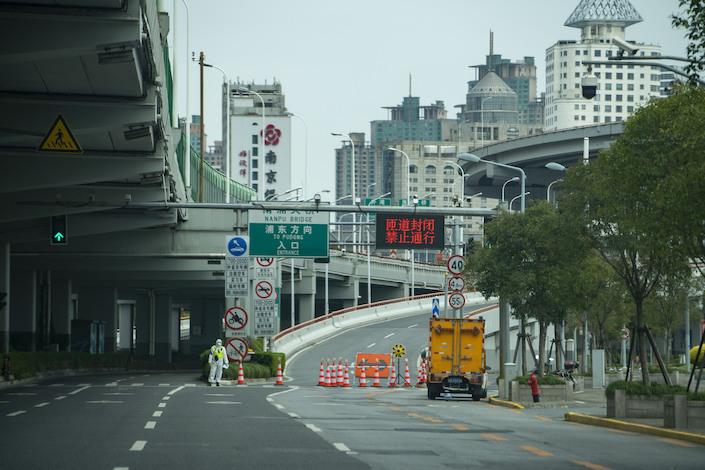
On March 27, Shanghai released a plan to start a two-phase citywide lockdown to test all of its 25 million residents amid the city’s worst Covid-19 outbreak since the pandemic began. Roughly divided by the Huangpu River, the east and west part of the city will take turns entering a four-day lockdown.
Shanghai is exploring a new path for domestic disease management. The city’s virus control teams have shown a strong scientific approach in the fight against Covid-19, and I am sure they will figure out a new path for epidemic prevention that is suitable for Shanghai.
Considering the strong infectivity of the omicron variant and Shanghai’s population density, some new ideas and methods can be considered for the virus control strategy. Here are some of my suggestions:
Rapid antigen testing with self-sampling should be recommended to replace mass virus testing. Such test kits have already been distributed to the public in the city.
Self-isolation at home should be allowed for close contacts and patients with mild symptoms instead of centralized quarantine. The most important thing is to use effective vaccines to protect high-risk groups such as the elderly and children to reduce severe illness. Approval of Pfizer’s mRNA vaccine for people older than 65 and younger than 5 should be considered.
Effective treatments need to be adopted to reduce fatalities. Pfizer’s Paxlovid Covid-19 pills can be used to treat early infections. This will turn the pandemic into an endemic disease and protect people.
It is necessary to strengthen the treatment of patients with effective drugs such as Paxlovid to reduce the new coronavirus case fatality and mortality rates. Successfully turning the pandemic into an endemic disease is a phased goal to effectively protect the health of the population.
Shanghai succeeded in controlling the virus between February and December 2021 with fewer than five new cases on daily basis. A rise in the case count started Dec. 15, with a record of 30 daily cases reported Jan. 14. The trend declined in the following month and then rebounded in late February. The caseload mentioned here don’t include asymptomatic patients, who reportedly account for 98% of Shanghai’s infections.

1. The trend of the pandemic
Where will Shanghai’s outbreak go? Considering the very high proportion of asymptomatic infections, the number of cases in Shanghai will continue rising for a while, and the previous recorded cases could be just the tip of the iceberg, as suggested by Wu Fan, vice dean of Shanghai Fudan University Medical school.
This is in line with my basic judgment based on Shanghai’s official data, which is relatively reliable. The lockdown measures announced March 27 and the nucleic acid screening may flatten the curve of cases and are likely to drive a decline.
But if hidden community transmission can’t be controlled — which may be impossible — new waves of outbreak will return, one after another. Therefore, only the establishment of an effective herd immunity barrier can effectively reduce the harm of the virus. Mass testing and quarantine can cut off sources of infection, but the use of specific vaccines against the virus is the strongest way to stop it.
2. Boosting vaccine protection
A recent study based on more than 20,000 Covid-19 patients and more than 40,000 healthy people showed that three-dose inoculation was 67% protective against the omicron variant and 93.5% effective against delta. The U.S. Centers for Disease Control and Prevention said unvaccinated people are 20 times more likely to die from Covid-19 compared with those who received two doses of vaccines. Data from Hong Kong indicate that three doses of Sinovac’s inactivated-virus vaccine can provide 97.9% protection for people older than 60 from severe illness or death. Therefore, we should recommend that the elderly in Shanghai get a third shot as a booster.

Shanghai has administered 55.49 million doses of Covid-19 vaccines and fully vaccinated 22.42 million people, 95.1% of the city's population, and 10.63 million people have received booster shots. With the current high vaccination rate in Shanghai, efforts to encourage people to take the booster shot and further increase inoculation among the elderly will effectively build an immunity barrier against severe illness and death. Therefore, home isolation for close contacts and asymptomatic patients can be considered.
The vaccination rate among Chinese elderly is low, reflecting the fact that the home-grown inactivated-virus vaccines didn’t involve enough older people in clinic trials. A large group of elderly with chronic diseases have been restricted from receiving the vaccines due to concerns over side effects. This is why I have been calling for faster approval of Pfizer’s mRNA vaccines to provide better protection for the elderly and children. Phase 3 clinical trials of the mRNA vaccine included a considerable proportion of the elderly and children and people with chronic diseases. Thus, there are few limitations for them to use the vaccine. With better protection or vulnerable groups, society will be able to open up smoothly.
Surely, any vaccine and medicine will have side effects. But weighing the pros and cons, if vaccination can save lives, it should be accepted. At the same time, not everyone can adapt to the vaccine, and people with immune system deficiencies and people who are prone to hypersensitivity reactions are not suitable. Such people need to strengthen their protection from the virus.
3. Self-isolation should be an option
To reduce the burden on the medical system, I suggest that close contacts, asymptomatic and mild patients should be isolated at home instead of at centralized quarantine sites.
Field hospitals that were built for asymptomatic and mild patients may create opportunities for the virus to spread due to the narrow spaces of the facilities. It may also pose risks for patients to be infected by different variants, offering a hotbed for further mutation. So, I recommend home isolation for those with light and undetermined infections.
Patients should be allowed to choose between self-isolation or moving to field hospitals based on their own conditions. Necessary conditions for home isolation include:
a. There must be clear regulations and requirements for self-isolation, as well as a standard quarantine plan.
b. People in self-isolation should be equipped with a blood oxygen saturation tester and oral drugs for cough, phlegm, and early treatment.
c. Have a channel to consult with doctors and virus prevention workers in a timely manner so that they can be sent to a hospital if their condition worsens.
d. It is recommended to establish an oxygen supply center in each community so that oxygen-deficient patients can be supplied in a timely way.
If self-isolation can reduce the infection risks of centralized quarantine, it should be considered for the public’s health and social-economic matters.
4. Pressure tests for hospital system
If Shanghai abandons the lockdown measures and allows home isolation, is it possible to overwhelm the city’s hospital system? I have made an assessment based on the city’s conditions and available information.
In 2020, the total number of medical and health institutions at all levels in Shanghai was 5,905 (including village clinics). The city's medical institutions had 161,500 beds. If 30% of the beds are designated for severe Covid-19 patients, the total would be 48,500 beds. Shanghai’s hospitals are equipped with more intensive care units than the national average of 4.37 per 100,000 people. The city’s ICU number could range between 2,852 and 5,700. These are only rough estimates, and some may not be in line with reality. I am sure the city’s disease control authorities have more accurate statistics on its hospital facilities and health workers.
Based on Shanghai’s caseload as reported March 26, there were 45 confirmed infections and 2,632 asymptomatic cases. If most asymptomatic patients are allowed to take self-isolation at home, Shanghai’s hospitals can handle many more patients that need treatments. If an average of seven days of hospitalization is needed, the city’s medical system can handle 6,000 to 7,000 patients a day, or 150 to 200 times the current case count.
The key is to formulate rules and regulations for home isolation so that close contacts and asymptomatic infected people can be isolated at home, and at the same time, measures must be taken to strictly protect medical staff so that the infection rate of medical staff is maintained at a fairly low level. This reduces the risk of medical runs and the collapse of the health-care system during periods of bigger outbreaks.
5. Self-tests should be deployed
Due to the high infectiousness of the new variants, group sampling and testing will lead to an increased risk of group infection. The method that China has long used to detect infections from mass testing is likely to be less feasible given the higher risks of mass infection during testing. Consequently, new approaches are needed to deal with the highly contagious mutations.
I recommend self-sampling for virus tests. Self-taken saliva samples for virus testing have been applied overseas with mature technology. China should also have this capacity. Rapid antigen test kits have also been distributed in Shanghai. Once they test positive, people should stay in self-isolation and report to disease-control staffs. If symptoms appear, patients can take samples themselves for nucleic acid tests to confirm infection and receive treatment based on conditions.
6. Timely treatment
The good news is that Pfizer's Paxlovid oral drug has been used in China. The drug can be used to treat adult patients with mild to moderate infections and the risk of getting worse. Take the medicine within five days of onset and use it for five consecutive days. The drug has a protection rate of more than 90% for preventing severe illness and death.

7. Summary
After more than two years of the pandemic, we have come to deeply understand the virus and develop effective and safe vaccines to prevent severe cases and deaths. There are also treatments proven to be effective.
I hope that Shanghai will be guided by science and explore new ideas and methods for virus control based on its actual situation. In this way, Shanghai can successfully turn the pandemic into an endemic disease, effectively protect the health of the population, and create a new epidemic prevention model for other cities across the country.
The author is the dean of the University of California, Los Angeles, School of Public Health.
The views and opinions expressed in this opinion section are those of the authors and do not necessarily reflect the editorial positions of Caixin Media.
If you would like to write an opinion for Caixin Global, please send your ideas or finished opinions to our email: opinionen@caixin.com
Get our weekly free Must-Read newsletter.







